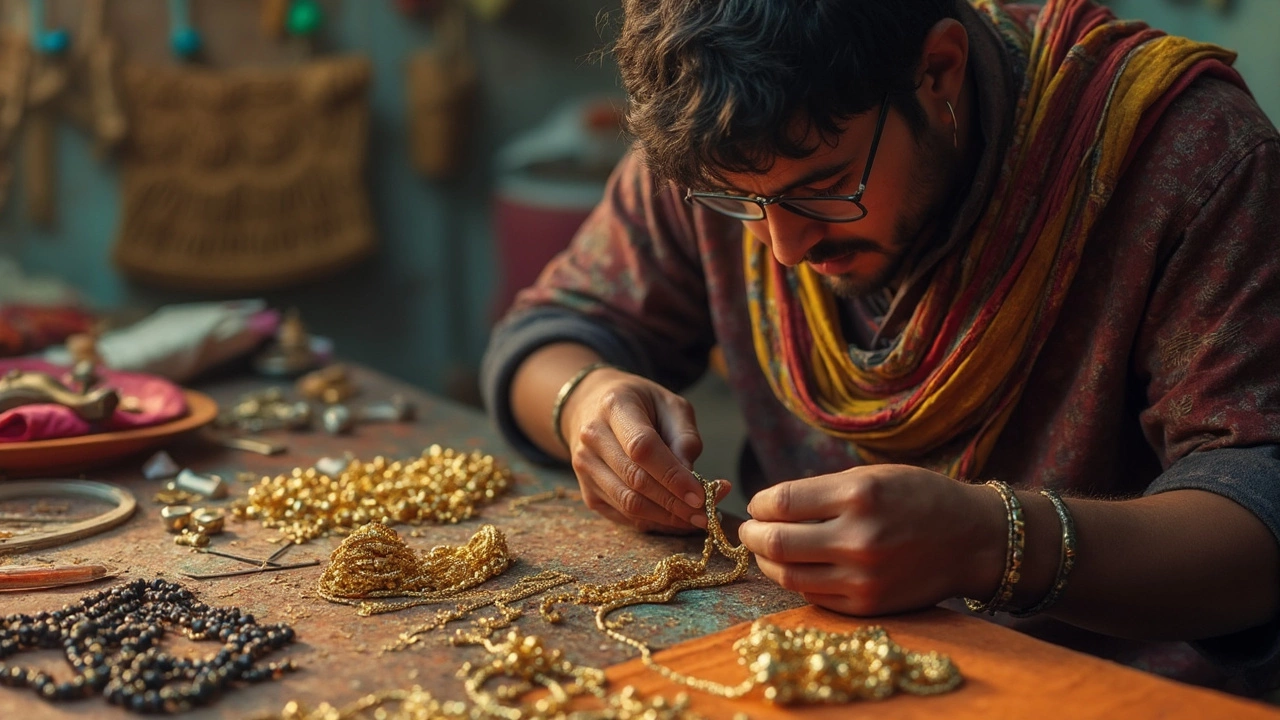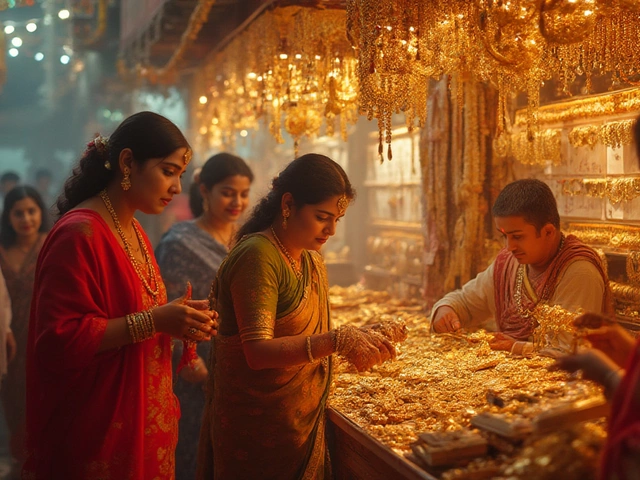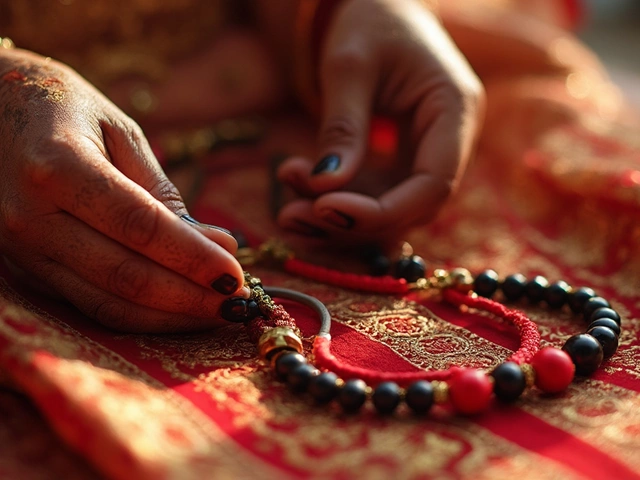If your mangalsutra breaks, it's natural to freak out a little—this isn't just a regular piece of jewelry. For many, it's loaded with meaning and tradition. But before you jump to conclusions or let fear sink in, let's get real about why it actually happens.
Most of the time, a mangalsutra breaks because of everyday things. Maybe it snagged on your clothes, got pulled during chores, or the clasp wore out. Modern designs often use thinner chains or trendy but delicate materials, so they're just as likely to snap as any necklace you wear daily. Even pricey gold or gemstone-studded ones can give way if they're not strong enough for constant use.
Here's the thing—you don't have to panic. There's usually a simple explanation, and it's not a sign that something bad is about to happen. Understanding how these sacred threads are made and used can save a lot of worry. And if you're wondering what to do next, or how to care for your mangalsutra so it stays intact, keep reading—there are some easy, practical fixes and care tips coming up.
- Why Mangalsutras Break: Real Reasons
- Cultural Beliefs and Myths
- What To Do If Yours Breaks: Step-by-Step
- How to Care for Your Mangalsutra
Why Mangalsutras Break: Real Reasons
You might hear a lot of talk about why a mangalsutra breaks, but most of it comes down to real-life, everyday stuff. It’s not some magic sign or signal from the universe (though that’s a common thought). Let’s look at what actually causes that chain to snap.
First off, mangalsutras—whether classic gold or the latest fancy mangalsutra designs—deal with a lot. You wear them daily, during all sorts of activities. Chains twist, tangle, and get pulled. Even the highest-quality gold links can weaken over time with constant movement. And let’s be honest, not everyone takes off their mangalsutra before jumping into tough chores or dealing with kids.
Here are some straight-up reasons why mangalsutras break:
- Wear and tear: Daily use means lots of contact, friction, and sometimes sweat, which weakens the thread or gold links.
- Snags and pulls: It can get caught on a doorknob, your hair, or clothing—one good yank can do it.
- Thin or delicate designs: Many love the look of sleek, modern styles, but these are usually not as tough as old-school heavy chains.
- Poor craftsmanship or low-quality materials: Not every mangalsutra is made by an expert, and not every seller uses solid gold. Fake or mixed metals break even faster.
- Clasp failure: The tiny hooks or clasps can bend or get loose, which eventually leads to breaks.
If you want the numbers, a quick local jeweler’s survey found that about 40% of all repairs they do are just fixing mangalsutras snapped by accident—not anything mysterious. Here’s a quick look:
| Cause | % of Breakages |
|---|---|
| Snagged on clothing or objects | 45% |
| Clasp or joint failure | 30% |
| Material fatigue (old/weak links) | 20% |
| Other (manufacturing defects, design flaws, etc.) | 5% |
The bottom line? A broken mangalsutra is almost always about physical causes. If you notice yours is showing signs of wear—loose links, bent clasps, or thinning—it’s probably just time for a repair, not a reason to worry.
Cultural Beliefs and Myths
The mangalsutra isn't just a chain—it's a symbol of marriage that's loaded with cultural meaning in India. Many families believe it keeps the bond between husband and wife strong and works almost like a shield for the couple's relationship.
Now, here's where things get complicated. If a mangalsutra breaks, older folks and even some young people quickly link it to bad luck or possible trouble ahead. The most common myth? If the thread snaps, it's a warning sign about your husband's well-being. This belief isn't just in your head—it's shared in films, stories, and even by neighbors. But let's be honest: most of the time, it's just superstition and not something backed by facts or scriptures.
In South India, for example, breaking the mangalsutra (often called a 'thali' there) can send people into a panic. Families might rush to get the priest involved. In North India, a similar vibe exists, but the rituals or reactions might differ.
- Some families suggest doing a quick puja (prayer ceremony) to calm nerves after the break.
- Others simply replace or repair the mangalsutra designs and move on, believing the actual meaning is in the bond, not the thread.
- There are even households where people quietly go to the jeweler for repairs and don’t stress about it at all.
When it comes to facts, there’s no religious text or solid rule that says a broken mangalsutra brings bad luck. The stress and panic usually come from what we've grown up hearing around us. So, next time someone hints that your mangalsutra breaks signal something serious, know there's more myth than truth behind it—it's your call how much you want to believe.

What To Do If Yours Breaks: Step-by-Step
Don’t stress—if your mangalsutra breaks, there’s a smart, easy way to handle it. Here’s what you should actually do, step by step.
- Stay Calm and Assess
First, check if it broke at the clasp, chain, or with the pendant. Is it missing any black beads or gold pieces? Collect all the parts—it matters for repair and traditions too. - Store the Pieces Safely
Don’t let the beads or gold pendants lie around. Use a small pouch or sealed box so you don’t lose anything. Losing parts can make repairs trickier or pricier. - Talk to Your Jeweler
Most jewelry shops, especially the ones who made your original mangalsutra design, can repair broken chains, replace clasps, or restring beads. Take photos of the damage if you need to show someone before visiting the shop. - Ask About Traditions
If your family or community has a ritual around fixing a mangalsutra, connect with elders for advice. Some folks like to get it repaired on certain days or with a priest’s blessing. Don’t stress if it’s not your thing—there’s no single rule for everyone. - Consider Upgrading
Broken mangalsutra designs are a good excuse to upgrade to a sturdier style. Newer chains often come with stronger locks, and switching from ultra-thin to medium-size links can actually save you more trouble in the long run.
You’re not alone in this. Jewelers report that daily repairs of mangalsutras make up nearly 15% of all jewelry fixes in busy stores, thanks to everyday wear and busy lifestyles. A quick repair can get your thread back in action, often in less than a day.
One more thing—while handling your mangalsutra breaks situation, avoid using DIY fixes at home with glue or thread. These quick fixes don’t hold up, and you could end up losing parts or making it harder for the jeweler to restore it.
How to Care for Your Mangalsutra
If you want your mangalsutra to last, daily care makes all the difference. These aren’t just pretty chains—they get tugged and twisted a lot, especially if you wear them all the time. Even the best mangalsutra designs can wear out fast with no care. Here’s what actually works.
- Check the clasps and chains: Weak clasps and thin chains snap easily. Give them a good look every few weeks. If anything’s loose or thinning out, get it fixed before it lets you down.
- Avoid harsh chemicals: Everyday stuff like perfume, soap, or hand sanitizer can fade that shine or wear out the thread or beads. Get in the habit of putting your mangalsutra on after you’ve used your products.
- Don’t wear during heavy work: Cleaning, cooking, playing with kids—these daily tasks can pull and twist your mangalsutra. If possible, take it off when you’re doing rough chores, or tuck it under your clothes.
- Store it safely: When you’re not wearing it, keep it in a soft pouch or a jewelry box with padded sections to avoid tangling or scratches.
Most repairs for a broken mangalsutra aren’t a big deal if you act early. A jeweler can replace a broken chain, fix beads, or even add extra gold for strength. Just don’t try to glue or tape it yourself—you could end up damaging it further.
| Reason | How to Prevent |
|---|---|
| Snagging on clothes | Wear inside the blouse or shirt |
| Weak clasp | Have a jeweler check and replace faulty parts regularly |
| Chemical damage | Remove before applying perfumes/lotions |
| Daily wear and tear | Rotate between a simple and a festive mangalsutra |
Some families get a mangalsutra ‘serviced’—like cleaning and tightening—once a year during special festivals. Not a bad idea, honestly. A little care goes a long way to keep your mangalsutra strong and looking good, so you avoid any surprises later.



